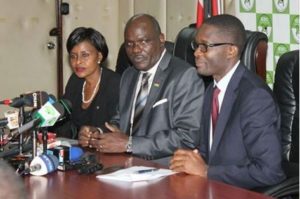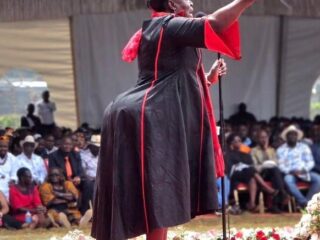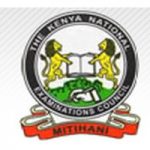The Independent Electoral and Boundaries Commission has revealed how it will announce election results.
In a press release, the electoral body clarified:
“It is now 12 days to the August 08, General Election and we wish to update the nation on the status of key processes towards a free, fair and credible election.
- Results Management Framework for Presidential Election
For purposes of the 2017 General Election, the Commission has reviewed the Court of Appeal judgment in light of elections operations and makes the following conclusions:
• That the polling station is the true locus for the free exercise of the voter’s will.
• That the votes cast at each polling centre shall be counted, tabulated and the outcome of that tabulation announced without delay by the presiding officer.
• That electronic transmission of election results in a prescribed form is a critical way of safeguarding the accuracy of the outcome.
• That it is not mandatory for the Returning Officers to “troupe” to the National Tallying Centre with hard copies of the collated results.
• That the role of the National Tallying Centre is to verify that the winning candidate in presidential elections has obtained 50% +1 votes and that the candidate has obtained at least 25% of the votes in at least 24 counties.
• That the results received from the Returning Officer cannot be changed or varied by the Commission at the National Tallying Centre. The same principle applies that the Returning Officer cannot change the results as received from the polling station.
• That the decision with regards to declaration of results can be subject only to an election petition.
Based on the above observations, the Commission approved the following guidelines, in addition to the Regulations, with regards to management of presidential election results:
A.Polling Station
After tallying and announcing of the results at the polling station, the Presiding Officer in the presence of party agents shall:
• Type into the KIEMS tablets the results as captured in F34A.
• Scan F34A using KIEMS tablet.
• Confirm that the typed results and the results on the scanned form are accurate.
• Electronically transmit the results to the Constituency Tallying Centre and the National Tallying Centre.
Form 34A shall be made available on an online portal.
B.Constituency Tallying Centre
At the Constituency, the Returning Officer:
• Receives scanned Form 34A.
• Collates results from Form 34A and prepares Form 34B.
• Announces results of the presidential election in that constituency.
• Scans F34B and sends it to the National Tallying Centre.
The Returning Officer shall also receive physical copies of Form 34As from polling station and together with Form 34B deliver the same to the National Tallying Centre for archiving.
- National Tallying Centre
The Commission has set up the Bomas of Kenya as the National Tallying Centre. In accordance with the decision of the Court of Appeal, at the following processes shall be undertaken:
• The scanned Form 34Bs from the constituency returning officers shall be received by two designated officers.
• Form 34B shall be authenticated by two designated officers. The authenticating Officers in the presence of Chief Agents for the candidates authenticate the origin of the Form.
• The Authenticating Officers serializes the received Form and hands over the same to Collation Team. There shall be 6 collation teams to serve the 47 counties.
• Collation Team generates relevant sections of F34C and hands the same to the Validation Team.
• The Validation Team verifies that the 34C is complete and accurate in as far as the collation of the results from the 290 constituencies is concerned.
• The Validation Team hands over to the Commission Form F34C that the Chairman of the Commission uses to declare the final results of presidential elections.
The declaration of the presidential results shall be based on the verification that the constitutional threshold has been obtained by the winning candidate.
The Commission also resolved to avail a dedicated link to the Media for purposes of relaying the results as received from the polling stations across the country.
The Commission shall also display the results as received from polling stations in all the tallying centers. The same results shall also be available on a web portal. - Electoral Security Arrangements
The mandate of the Commission is to deliver free, fair and credible elections. This can only happen if we have a peaceful environment in which voters will exercise their rights to vote. There should be no violence, threats to violence, intimidation or coercion.
It is the duty of the Commission to collaborate with other actors to ensure that the election environment is secure. Accordingly, we must work with security agencies that have the responsibility to maintain law and order and the protection of life even during the election period.
The Commission’s Election Operation Plan (EOP) 2015 – 2017 identifies election security as a key objective to credible elections. Further, the Commission conducted a baseline survey on electoral related violence in January, 2017. The survey revealed several security hot spots countrywide and probable causes. We have used these reports to design appropriate interventions.
The Commission also launched the Election Security Arrangement Project (ESAP) on May 9, 2017. This is a program sponsored by UNDP. It brings together National Police, Office of the Registrar of Political Parties (ORPP), National Steering Committee on Peace Building and Conflict Management and IEBC. The overall objective of ESAP is to train 180,000 Police Officers and Special Police Officers who will be deployed during the General Elections. The training covers Election Security and Election Laws generally and Election Offences specifically. We are on course in implementing this programme.
- Security and Order at the Polling Station
Regulation 63 of the Elections (General) Regulations bestows upon the presiding officer the overall duty to keep order at his or her polling station. The presiding officer may order the removal of any person who misconducts himself or herself at the polling station, or fails to obey any lawful instructions or orders of the presiding officer and such person shall be removed by the police officer present.
The presiding officer may order the dispersal of any gathering of persons which appears to the presiding officer to be preventing free entry to, or exit from, the polling station or to be intimidating or interfering with voters, and any such order shall be sufficient authority for a police officer, or any other person authorized by the order, to effect the dispersal.
The power conferred on a presiding officer and a police officer shall extend to a radius of not more than four hundred meters from the centre of the polling station. In exercising these powers, caution must be exercised to ensure that a voter who is entitled to vote at the polling station is not prevented from having an opportunity to peaceably vote at that polling station.
The Commission shall deploy at least 2 security officers per polling station across the country. The role of these officers will be to secure election materials as well as maintain order at the polling station. While working at the polling station, they are under the leadership of the presiding officers.
In order to enhance effectiveness and efficiency, the Commission is engaging the Office of the Inspector General of Police and Ministry of Interior on deployment of the required number of officers during elections.
Thank you very much.
W.W. CHEBUKATI
CHAIRMAN














